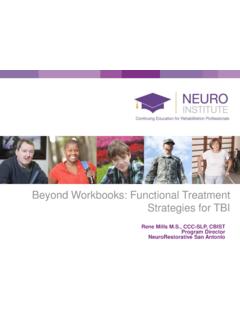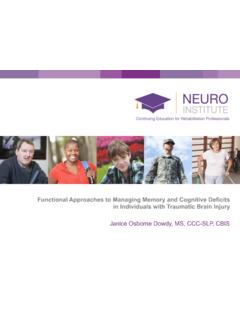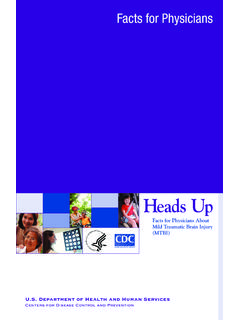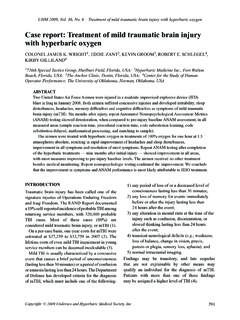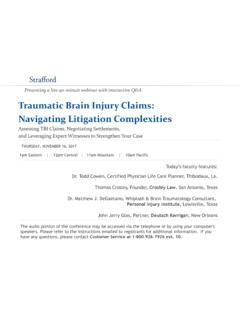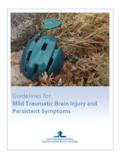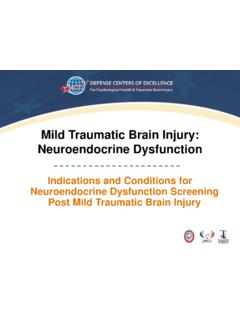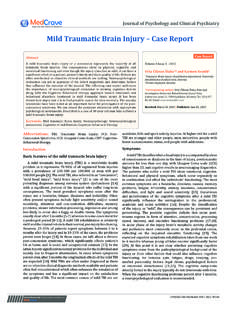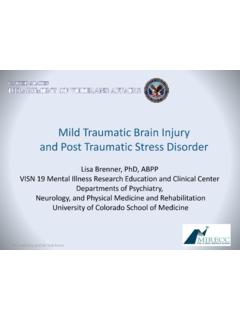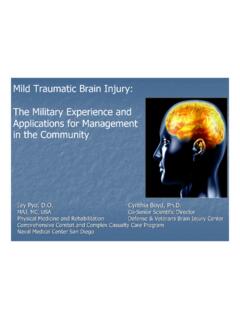Transcription of Understanding Mild Traumatic Brain Injury and ...
1 CEU for CCM & CDi' "- ' hours of CCM and CDMS e( Understanding mild Traumatic BrainInjury and postconcussion SyndromeBy Frank D. Lewis, PhD, and John Lucas, MA, LPC, LMFTD espite having a label of " mild ," mild Traumatic Brain Injury (MTBI) is a major publichealth problem in the UnitedStates, according to the Centers forDisease Control and Prevention (CDC).It is estimated that up to millionpeople sustain a MTBI each year theUnited States. MTBI accounts for morethan 1 million (or 1% of) yearly emer-gency department visits. Most MTBI soccur to persons under the age of 24or older than age 74. Fifty percentof MTBIs result from motor vehiclecrashes, 25% from falls, 15% fromassaults, and 10% from sports inju-ries. Most fall injuries occur in thoseyounger than 5 and older than 75.'In 2001, the CDC reported thecost of MTBI to be $ Mostof this economic cost was the resultof lost productivity. These figures donot include the indirect cost of familycaregiver expense and those who weretreated in the emergency department,released, and then received subsequentcare in other hospitals for symptomsrelated to their Injury .)
2 A study byBoake and colleagues2 found thatMTBI patients had similar duration ofwork absences as did general traumapatients. In their study, work absencesresulting from MTBI ranged from 1week to 3 months. Other researchershave reported unemployment ratesFrank D. Lewis, PhD, is Director of ClinicalOutcome Services and Clinical Director atNeuroRestorative Georgia in Augusta. JohnLucas, MA, LPC, LMFT, is in Private 15% 2 years from the onset of Perhaps the most importantstep in ensuring that these patientsreceive access to proper care is a thor-ough Understanding of the definitionand diagnosis of and DiagnosisFailure to properly diagnosis a MTBIcan readily lead to symptom exacer-bation and chronic emotional andphysical problems. An accurate under-standing of the disorder will help casemanagers make better decisions regard-ing the nature, frequency, and durationof treatment necessary to minimize theseverity of symptoms.
3 However, definingand diagnosing MTBI has proven to bechallenging. Traditionally, diagnosisof MTBI relied heavily on the GlasgowComa Scale (GCS), a broad measureof neurologic functioning, rangingfrom nonresponsive-to-external-stimulito fully oriented and conversant. TheGCS emphasis on consciousness leveland depth of coma has significant valuefor directing the emergency care ofmore severe neurological injuries, yetunderestimates the presence of signifi-cant symptoms of MTBI. For example,most MTBIs are admitted to emergencydepartments with the highest GCSscore of 15, which could be erroneouslyinterpreted as normal neurologicalfunction. In response to these limita-tions, more comprehensive Injury classi-fications have been developed. In 1993the America Congress of RehabilitativeMedicine defined a MTBI as onethat resulted from a blow to the headcausing any alteration of mental statuswith the following criteria: (1) loss ofconsciousness not exceeding 30 min-utes, (2) after 30 minutes an initialGCS score of 13 to 15, and (3) post- Traumatic amnesia (PTA) not lastinglonger than 24 hours.
4 ' Although widely-used, this system of classification lacksthe clarity and specificity necessaryto detect characteristic symptoms ofMTBI. The symptoms that should beconsidered are presented in Table address these limitations andimprove diagnostic accuracy, theCDC6 published a detailed operationaldefinition of MTBI in 2003. Its criteriainclude the following: Any period of observed or self-reported transient confusion, disori-entation, or impaired consciousness Any period of observed or self-reported dysfunction of memory(amnesia) around the time of Injury Observed signs of other neurologicalor neuropsychological dysfunction,such as:- Seizures acutely following headinjury- Among infants and very youngchildren: irritability, lethargy, orvomiting following head Injury - Symptoms among older childrenand adults such as headache, diz-ziness, irritability, fatigue, or poorconcentration (when identifiedsoon after Injury can be used tosupport the diagnosis of mild TBI,but cannot be used to diagnosis inthe absence of loss of conscious-ness or altered consciousness)8 CareManagement February/March 2012 Exclusively for ACCM Members Any period of observed or self-reported loss of consciousness lasting30 minutes or lessSince 2003, several organizationshave published definitions of MTBI,with considerable overlap of acuteinjury characteristics.
5 McCrea' providesa summary and review of various defini-tions. Taken together, these definitionsforge a consensus among profession-als as to the defining characteristicsof MTBI. With this Understanding ,research is now advancing in the areaof neuroimaging techniques with thehope of providing precise assessment ofthe structural and functional changesthat are correlated with subtle neuro-logical Injury and and MTBIT raditionally, head CT scans are takenin emergency departments to detectthe presence of moderate and severebrain injuries. The CT scan is effectivein detecting structural abnormalitiesand hemorrhagic lesions that requiresurgical intervention. The CT scans,however, lack the sensitivity necessaryto detect small petechial hemorrhagesand cellular dysfunction associated withMTBI. While effective in ruling out theneed for surgical intervention, relianceon CT can lead to a false assumption ofnormal Brain not foolproof, magneticresonance imaging (MRI) is more sen-sitive for detecting subtle Brain abnor-malities caused by MTBI.
6 A review ofstudies in which patients were givenboth CT and MRI scans found that theMRI detected Brain abnormalities in30% of the patients that had normalCT scans. Despite the increased capa-bility to reveal Brain abnormalities,MRIs have been shown to be only mini-mally effective in predicting the pres-ence of symptoms long tensor imagining (DTI),a relatively recent variation on MRI,can detect small neural abnormali-ties not seen on the traditional , it is possible to observemicroscopic abnormalities of white mat-ter neural tracts using DTI. Also, DTIallows researchers to detect improve-ment in neural connectivity followingbrain neuroimaging does identifyabnormalities after a MTBI, the injuryis considered to be a "complicatedMTBI." If the scans are normal, theinjury is classified as "uncomplicatedMTBI." Patients with complicatedMTBI with lesions, sustained meta-bolic change, or diffuse Injury are atrisk for slow or incomplete and colleagues10 found thatMTBI patients with identifiable lesionsexperience outcomes more similar topatients with moderate Brain injuryas measured by GCS.
7 These patientsexperienced significant symptoms 1year post- Injury . Symptoms were severeenough to prevent return to work ornormal productive of InjuryThe neurological damage caused by aMTBI was once thought to occur in thesame fashion as that of moderate andsevere injuries. Shearing or rotationalforces resulting from a blow to thehead cause tearing and misalignmentof axons and ultimately death of thecell. The damage, referred to as diffuseaxonal Injury , is widespread, typicallyconcentrating at the junction betweenthe gray matter of the cerebral cortexand the white matter of ascending anddescending neurons. The ability torecover from such injuries relies pri-marily on adjacent uninjured neuronsassuming function of the damagedneurons. Concussions or MTBLs wereconsidered to be a milder form of dif-fuse axonal research suggests a morehopeful model of mild injuries, whichinvolves cellular dysfunction instead ofdeath.
8 A blow to the head of sufficientforce to cause a MTBI initiates a pro-cess of accelerated neurotransmitterSymptoms of mild TraumaticBrain InjuryPhysicalHeadacheSeizure acutely following blow toheadNauseaVomitingDizzinessFatigueHype rsensitivitySleep disturbanceNumbness/tinglingCognitiveDec reased attention/concentrationShort term memory deficitsDiminished capacity of workingmemoryDecreased processing speedDecreased verbal fluencyDiminished executive functioning :planning, judgment, insightEmotional/BehavioralMood changes or mood swingsDepressionAnxietyIrritabilityrelea se, which increases cellular metab-olism and impairs the connectivity ofneurons. Giza and Hovda" refer to thisdisruption in function as a "neurologicmetabolic cascade." This disruption ofcellular function causes posttrau-matic amnesia, headache, and the rFebruary/March 2012 CareManagement 9 CEU for CCM & CDMS2 hours of CCM and CDMS education creditother cognitive symptoms of MTBI.
9 Inuncomplicated MTBIs, neurologicalfunction typically returns to normalafter a period of days to weeks. As nor-mal neural function returns, symptomssubside. In rare cases, symptoms persistfor an indefinite period at which timethe patient may be given a diagnosis ofpostconcussion syndrome (PCS). postconcussion SyndromeIn medical terminology, a syndromeis defined as the presence of clinicallyrecognizable features or characteristicsthat occur together and in which thepresence of one or more features indi-cates the possibility of the presence ofothers. In the case of postconcussionsyndrome, symptoms are preceded amaximum of 4 weeks by a MTBI witha loss of consciousness. Additionally,diagnosis requires symptoms in atleast three or more of the followingcategories12: Headache, dizziness, malaise, fatigue,noise tolerance Irritability, depression, anxiety,emotional lability Subjective concentration, memory,or intellectual difficulties withoutneuropsychological evidence ofmarked impairment Insomnia Reduced alcohol tolerance Preoccupation with the above symptoms and fear of Brain damagewith hypochondriacal concern andadoption of a sick roleOther features that may be asso-ciated with PCS include changes inpersonality, apathy, lack of spontaneity,learning difficulties, and worseningacademic performance (children) oroccupational performance (adults).
10 As is the case with MTBI, diagnos-ing PCS can be quite of the syndrome is plaguedwith poor Many of the symp-toms are subjective and may have beenpresent, at least in part, prior to theTBI. Also, PCS symptoms are similar toother disorders, such as fibromyalgia,chronic pain, and chronic reported that 90% of personswith depression and no TBI historywould likely meet PCS criteria. In addi-tion to symptom overlap, several demo-graphic and psychosocial factors arepredictive of PCS after a MTBI includ-ing female gender, older age, unstablerelationships, lack of social support,preexisting psychiatric problems, chem-ical dependency, and litigation. Somehave hypothesized that depression,anxiety, and stress in the weeks fol-lowing a head Injury contribute to thepersistence of symptoms." Therefore,to be effective, treatment models mustaddress the underlying psychologicalfactors maintaining the for Clinical ManagementObviously initial treatment is oftengiven in the emergency department,where more serious Brain Injury isruled out.

